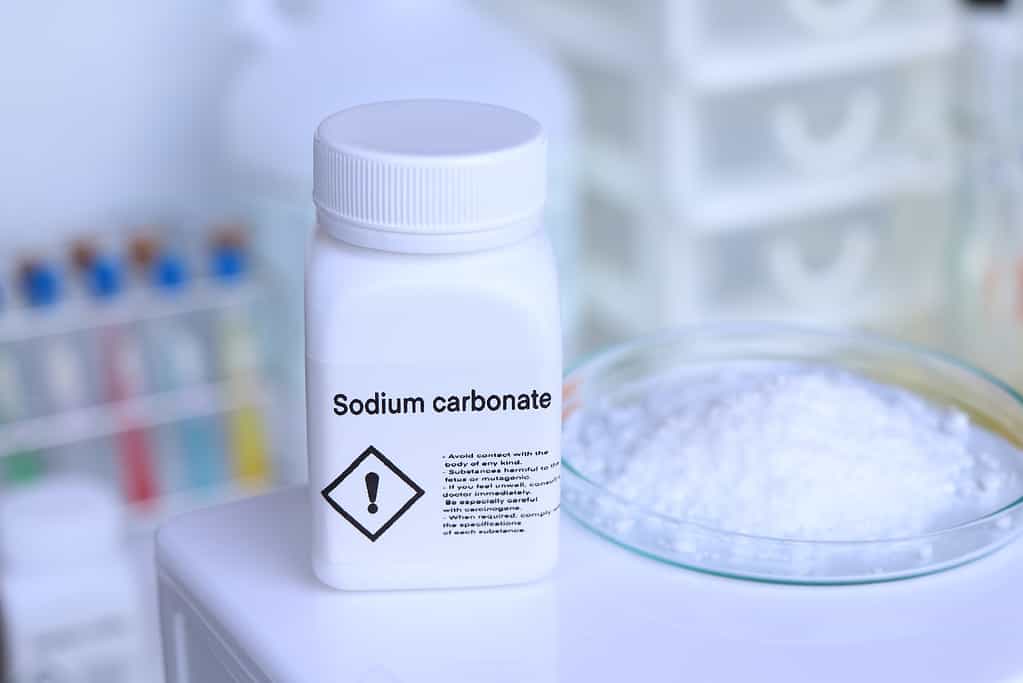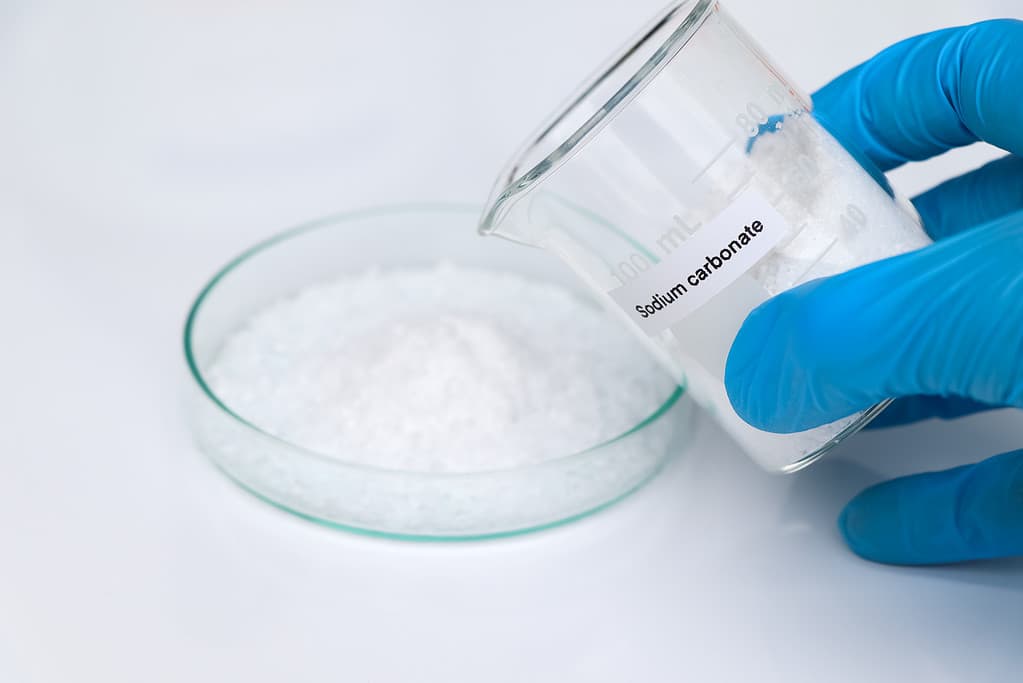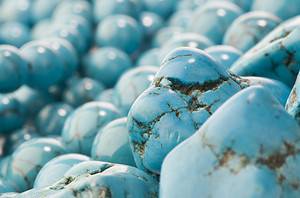Sodium carbonate, commonly known as soda ash, is readily found around the world. It has many uses, from manufacturing to food and medicine. You may have encountered this compound as washing soda. Do not confuse it with sodium bicarbonate, also known as baking soda. The two chemicals are similar, but not the same. Sodium carbonate exists in deposits around the world, with the biggest in the Green River area in the United States. In this article, we will discover the molar mass of calcium carbonate, take a closer look at its atomic structure, and learn about how this chemical compound is collected and used.

Sodium carbonate has a pH of 10 to 11. Handle this compound with care.
©Kittisak Kaewchalun/iStock via Getty Images
The Molar Mass of Sodium Carbonate
Sodium carbonate is a chemical compound, which is defined as a pure substance. Pure substances have the same exact chemical composition all throughout, unlike mixtures which do not have a uniform composition. Pure substances include things like carbon dioxide, oxygen, and pure water, as opposed to air or juice. A pure substance is made of exactly the same thing all the way to its smallest particles. The smallest particles in elements are atoms, whereas the smallest particle of a compound is a molecule. Pure substances include every defined chemical compound and each element on the periodic table. Each pure substance has a specifically defined molar mass which influences the physical and chemical properties of the substance. The molar mass of sodium carbonate is 105.99 grams per mole.
What does the term, molar mass, really mean? The molar mass of a pure substance is defined as the mass of one mole of that substance expressed in grams. Molar mass is used frequently in chemistry.
Molar mass is based on a scientific unit, the mole, which refers to a specific number of things. You could use moles to measure any type of object, but in chemistry, a mole usually measures a specific number of atoms or molecules. That number, known as Avogadro’s number or Avogadro’s constant, equals approximately 6.022 × 1023 units. This constant, named for the Italian scientist, Amadeo Avogadro, equals the same amount every time, and it is essential to understanding chemistry and how the world works.
Molar Mass vs. Atomic Mass
You can use the atomic mass of an element or compound to determine its molar mass. First, find the atomic mass of the element on the periodic table. It is usually listed just below or to the left side of the chemical symbol. Look at the key on the table to determine where to find the atomic mass.
The atomic mass of any element is measured scientifically, by taking account of all the known isotopes of the element and weighting their value by their proportion as found in nature. This weighted average equals the atomic mass for that element. Some elements have only one isotope, while others have many.
Every individual proton or neutron in an isotope has a value of one atomic mass unit. Each isotope of an element has a fixed number of protons, which equals the atomic number of the element. The number of neutrons each isotope of the element has varies. Meanwhile, electrons are so tiny that their mass, no matter how many electrons there are, can be disregarded. So, the atomic mass of any isotope equals the number of protons it has plus the number of neutrons.
Carbon Isotopes
We can take carbon as an example to help better understand isotopes and how their atomic mass is measured. Carbon, atomic number six on the periodic table, has just three different isotopes: carbon-12, carbon-13, and carbon-14. Each isotope has exactly six protons. The carbon-12 isotope has six neutrons. Therefore, its atomic mass equals 12. Carbon-13 has seven neutrons, which results in an atomic mass of 13. Meanwhile, carbon-14, a radioactive carbon isotope used in dating organic materials, has eight neutrons. That gives it an atomic mass of 14.
If you took the average of these three numbers, you would get 13. But the calculated atomic mass of carbon, 12.011 atomic mass units, is much closer to 12 than to 13. That is because carbon-12 isotopes far outnumber carbon-13 and carbon-14 in nature. Therefore, when scientists take into consideration the proportion of these isotopes present in nature, the atomic mass skews heavily in favor of carbon-12.
Calculating the Molar Mass of Sodium Carbonate
Once you know its atomic mass of an element, you can easily determine its molar mass. You simply take the element’s atomic mass and express it in grams. The mass of one mole of atoms of an element equals the element’s atomic mass, but in grams instead of atomic mass units.
Use this same concept to determine the molar mass of compounds. Compounds contain two or more atoms of the same or different elements in each molecule. First, find the atomic mass of each atom in the compound, then add them all up to find the atomic mass of the whole compound. Convert the atomic mass of the compound to the molar mass by changing the units to grams.
Sodium carbonate, Na2CO3, has six atoms in each molecule. It has two sodium atoms, one carbon atom, and three oxygen atoms. Therefore, one mole of sodium carbonate molecules would have two moles of sodium atoms, one mole of carbon atoms, and three moles of oxygen atoms. To find the mass of one mole of sodium, just convert the atomic mass of sodium to grams. One mole of sodium has a mass of 22.99 grams. One mole of carbon has a mass of 12.01 grams. And each mole of oxygen has a mass of 16.00 grams. Adding the mass of the six atoms in this compound gives a total of 105.99 grams as the molar mass of sodium carbonate.

Sodium carbonate is a white, odorless powder.
©Kittisak Kaewchalun/iStock via Getty Images
Atomic Structure of Sodium Carbonate
Sodium carbonate, Na2CO3, is an inorganic salt, much like sodium chloride, NaCl or calcium chloride, CaCl2. Like many other types of salts, this compound contains a polyatomic ion, or an ion made up of more than one type of atom. Inorganic salts feature one or more positively charged ions, known as cations, bonded ionically to one or more negatively charged ions, called anions. The net charge of a salt equals zero. Salts often combine metals from Group 1 of the periodic table, the alkali metals, or Group 2, the alkaline earth metals, with negatively charged non-metals, such as the Group 17 halides or polyatomic ions, such as the CO32- carbonate ion.
Both the familiar table salt, sodium chloride, and sodium carbonate are salts that are composed of two ions. A positively charged sodium ion, Na+, and a negatively charged chlorine ion, Cl–, combine to form sodium chloride. Sodium carbonate contains three times as many atoms, but still combines just two ions. The negatively charged carbonate ion, CO32-, in sodium carbonate is called a polyatomic ion because it combines two or more atoms that work together as a single unit. They function just like other ions made of just one atom. The carbonate ion has four atoms all working together with a net charge of -2.
Bonding to Form Compounds
When cations and anions join together to form compounds, each ion seeks to fill its orbitals with enough electrons to reach a stable configuration. This stable configuration gives each atom in the compound a stable configuration, often equal to that of the nearest noble gas, or Group 18 element.
Ionic bonding, the type used in the formation of salts like sodium carbonate, involves the giving and taking of electrons. This type of bonding differs from the sharing of electrons used in covalent bonding, as seen in molecules like carbon dioxide. Many compounds use covalent bonding and share electrons to reach the desired noble gas configuration, but sodium carbonate and other salts trade electrons through ionic bonding to reach that stable configuration.
Sodium, a metal from the Group 1 alkali metals group, has a lone electron in its outer shell. The easiest way for a sodium ion, Na+, to reach the stable configuration of the nearest noble gas, argon, is to give away its extra electron. Carbonate, a polyatomic ion with a -2 charge, needs two extra electrons to finish filling up its outer shells. It can reach its desired configuration by accepting two electrons.
Sodium Carbonate Bonds
When a pair of sodium ions each give the single electrons from their outer shells to a polyatomic carbonate ion, ionic bonds form resulting in sodium carbonate. Each carbonate ion, with its -2 charge, can bond with two sodium ions, each with a +1 charge, to form a molecule with a neutral charge. The following chemical equation shows this reaction.
2Na+ + CO32- → Na2CO3
When studying the atomic structure of sodium carbonate, be aware that this compound contains both ionic and covalent bonds. The bonds between the sodium ions and the carbonate ion are ionic. But the bonds between the carbon and oxygen atoms that make up the polyatomic carbonate ion are covalent, meaning that they share electrons instead of trading them.
Sodium Carbonate in Nature
Sodium carbonate exists in nature in a variety of forms. One of the most abundant and important sources of sodium carbonate is a crystalline compound known as trona. Large deposits of trona, composed of sodium carbonate bound to sodium sulfate, exist in the United States, as well as Turkey, China, and parts of Africa including Namibia, Tanzania, and Kenya.

Lake Natron in Tanzania is a natural source of sodium carbonate.
©Rahim Mngwaya/iStock via Getty Images
Companies obtain sodium carbonate by mining underground or on the surface of the Earth. Formations exist near volcanoes and hot springs, as well as evaporated lake beds. People have historically obtained sodium carbonate from plant sources as well, though the process is labor intensive and more costly than mining.
Generation of Sodium Carbonate
Through the years, multiple chemical processes have been used to generate sodium carbonate from other compounds. None have proven as cost effective as mining, but some are simple enough to do at home. The Leblanc process, used mostly through the 1800s, required multiple steps and produced undesirable waste in the form of hydrochloric acid and calcium sulfide. The Solvay process proved much more efficient and became the manufacturing process of choice by the turn of the 20th century. Later, the Hou process utilized sodium chloride, ammonia, and carbon dioxide to produce sodium carbonate. The byproduct, ammonium chloride, could be used as a fertilizer, thus eliminating waste.
Common Uses of Sodium Carbonate
Sodium carbonate has many uses. Listed below, some of the most common uses account for most of the production of sodium carbonate.
Food Additive
Sodium carbonate must not be confused with sodium bicarbonate, also known as baking soda. Sodium bicarbonate, or sodium hydrogen carbonate, has the formula NaHCO3. It substitutes a positively charged hydrogen ion in place of one of the sodium ions in sodium carbonate, Na2CO3. Both of these chemicals, however, can be used as food additives. Cooks use sodium carbonate to reduce acidity in foods such as noodles, breads, and cakes. It affects gluten and generally makes foods like these chewier.
Manufacturing
Sodium carbonate sold as washing soda can be used as an ingredient in detergents. The compound plays an important role in the manufacture of some kinds of glass. Makers of bricks also use it to help with extruding clay. The compound is a highly effective water softener and can even be used to remove lime scale from pipes. Sodium carbonate has uses in soap making and in paper processing. It has proven effective for certain uses in the textile industry and is sometimes used as an abrasive for cleaning purposes.
Medical Uses
Sodium carbonate can be used as an antacid due to its ability to neutralize acids. Drug manufacturers also use it as an inactive ingredient in several different types of pharmaceuticals, including medicines for diabetes and high cholesterol. Sometimes manufacturers include this compound in topical medications, vaginal douches, and even mouthwashes.
Dangers of Sodium Carbonate
Sodium carbonate is basic, with a pH between 10 and 11, high enough to be useful in neutralizing acids and adjusting the pH level in pools, aquariums, and manufacturing operations. Because this compound is a relatively strong base, it can cause harm, especially in concentrated forms.
Users should wear safety goggles and gloves when working with sodium carbonate. If it comes into contact with the eyes, it can cause burns and irritation. Inhalation may cause damage to mucus membranes, including those in the lungs. This compound can also cause damage to the skin with prolonged exposure. Call emergency services or seek medical attention if you experience a sodium carbonate injury. If you suspect accidental ingestion of this compound, do not induce vomiting. Call poison control immediately and seek medical attention.
Other Sodium Compounds
Let’s take a look at several other sodium salts. The compounds below all include one or more positively charged sodium cations and one or more negatively charged anions. The larger the mass of the negatively charged ion, the larger the molar mass of the compound will be.
| Compound Name | Chemical Formula | Molar Mass | Primary Uses |
|---|---|---|---|
| Sodium carbonate | Na2CO3 | 105.99 g/mol | Food additive, water softener, glass |
| Sodium chloride | NaCl | 58.44 g/mol | Food additive, medical use, de-icing |
| Sodium nitrite | NaNO2 | 69.00 g/mol | Precursor to organic compounds |
| Sodium acetate | C2H3NaO2 | 82.03 g/mol | Food, laboratory, heating pads |
| Sodium bicarbonate | NaHCO3 | 84.01 g/mol | Food additive, acid neutralizer |
Conclusion
As you have learned, calcium carbonate is an important chemical compound that occurs naturally in our world. This salt has a more complex structure than diatomic salts. However, it is still composed of a single positively charged cation and a negatively charged polyatomic anion. Calcium carbonate has many uses, from construction and manufacturing to dietary supplements and medicine. We can find this highly versatile compound easily in nature, and we can also produce it in the lab. Our world truly would not be the same without it.
Thank you for reading! Have some feedback for us? Contact the AZ Animals editorial team.








